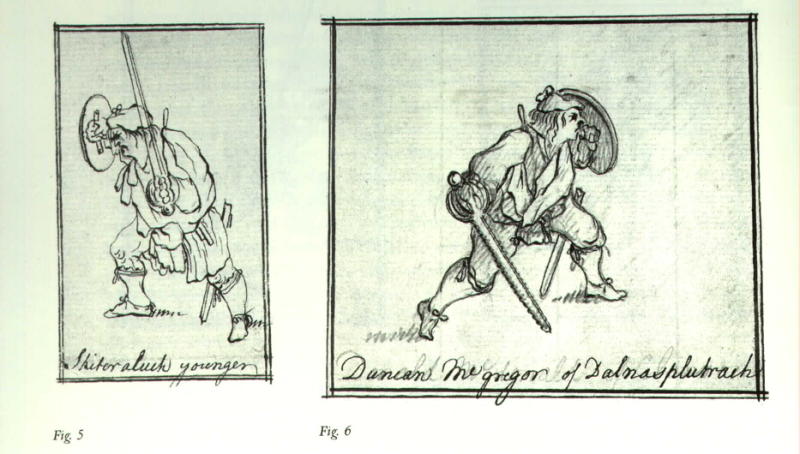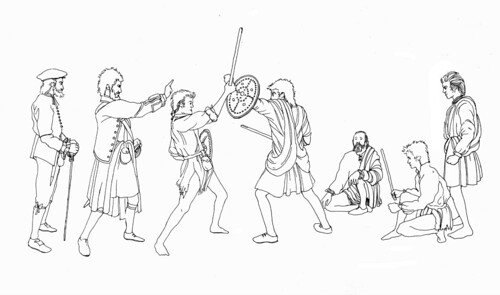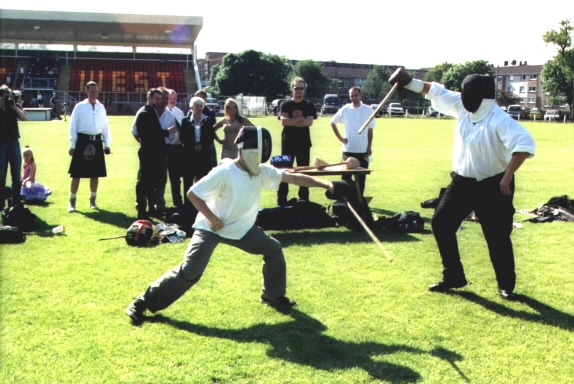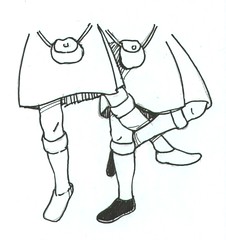It may come as a surprise that the Scots practiced and developed systems of armed and unarmed combat with dance-like
forms or kata, an abdominal shout similar to the Japanese Ki-ai, conditioning exercises and meditation techniques. Scots can
be found among many of the western masters who wrote and published treatises of their techniques, styles & theories. They
include stick-fighting, swordsmanship and grappling, many of which are illustrated and now widely available on the internet.
These arts were practiced throughout the British Isles and Ireland, although on the surface, little evidence remains today,
other than those kept alive in the traditions of morris dancing, sword dancing, country fairs and Highland games.

In Scotland, Martial art gymnasiums, referred to in Gaelic as Taigh Suntais, were training schools that existed in
the Highlands until the British government proscribed the weapons of the Highlander and dismantled the clan system, after
the battle of Culloden in 1746. Similar to the martial art dojo's of Asia, the first recorded taigh suntais was erected by
Domhnuil Gruamach, Lord of the Isles in 1400 for his strongmen and wrestlers. In later years, sons of successive clan chiefs
created their own gymnasiums where training was often held in the open air. “It was a custom in the Highlands of Scotland
before the year 1745 that the gentry kept schools to give instruction to youths in sword exercises, and the laird of Ardsheil
kept a school for the instruction of the youth of his own district. He stored the cudgels behind his house. There were cudgels
for the lads, and there were cudgels for the laddies, and the lads and laddies went every day to Ardsheil to receive instruction
on the cudgel from the laird. After the laddies had received their day's instruction each got a bannock and lumps of cheese.
They were then sent to try who would soonest ascend a mountain and eat the bannock and cheese; and whoeverwas first got another
bannock and lumps of cheese home with him."

Sometimes the laird's champion or a skilled veteran of the European wars was employed to instruct the young men of
the clan, who from the age of six, practiced the art of single-stick, wrestling, archery, dancing, swimming, leaping and pitching
stones. In time the single-stick would be replaced with the broadsword dirk and targe and as the warrior became proficient
in the arts, he could be expected to test his skills by competing against the youth of friendly clans in swordplay, wrestling,
throwing the stone or tossing the caber. These contests would be re-created in a fashion in 1826 as the 'Highland Games'.
SINGLE-STICKFIGHTINGStick fighting, was a popular pastime throughout the whole of
the British Isles. In Scotland young men would learn the seven angles of attack and six guard positions and like the Phillipino
systems, training involved the use of the left hand to parry or disarm, and wrestling throws & trips. The weapon typically
consisted of a yard-long ash wood stick with a wicker basket guard, which was usually the combatant's only protection. Village
fairs and Highland Games often held singlestick or cudgelling matches which began with the short prayer, "God, spare our eyes",
after which the object of the game was to break each others heads, "for the moment that blood runs an inch anywhere above
the eyebrow, the old gamester to whom it belongs is beaten".
 Singlestick revival at Milngavie Highland Games
Singlestick revival at Milngavie Highland GamesIn the western isles of
Scotland an old Skye dancing song, Bualidh mi u an sa chean, (I will break your head for you) still survives, which might
indicate that this form of stick-fighting was fought to music or 'danced'.
Training was just as tough as any Eastern
martial system, students were not spared the "kiss of the ash plant" and no doubt many suffered fractured skulls, and broken
bones. Although there are no records of 'death matches' there are accounts of combatants almost beating each other to death
and having to be hospitalised.
WRESTLING & COMBATIVE DANCE
Wrestling was another pastime of the Highlander
and carvings dating between the 7th and 9th century depicts the earliest form of unarmed combat in Scotland, the loosehold
and backhold styles of wrestling. It's not surprising to find that the oldest forms of Highland dance with it's kicks and
sweeping leg movements would seem to imitate many of the wrestling techniques found in Celtic wrestling and the Viking style
of "Glima". As in Asian martial arts, combative dances could have been used to train clansmen in the rudiments of unarmed
combat to circumvent the laws that prohibited combative training in times of government prohibition. This tradition of militaristic
dance has survived into the present day within Highland regiments of the British Army, although the possible combative applications
would seem to have been long forgotten.

Highland dance was also performed with weapons including the Lochaber axe, the broadsword, targe & dirk and the
flail. The Highland Dirk Dance, which resembles a combative dance similar to those of Indonesian Penjak Silat, has the performer-executing
knife techniques combined with kicks, trips and sweeps. One version of the dance involved attacking and defensive techniques
with single-sticks and targe shields and was last performed in Britain in 1850 by two brothers named MacLennan. Another version
that still survives was recovered in Canada by renowned dance researchers Tom and Joan Flett, back in the 1950's. (Interestingly
the dance was passed to Mr Flett only on the condition that it was a personal dance and not to be made public).
The
origins of Scottish combative dances with swords, cudgels or unarmed fighting techniques, are impossible to trace, the ancient
custom of dancing over crossed swords as in the Ghillie Callum has long been linked with an ancient victory or battle dance
but just like the Filipino Escrimador, who steps over crossed swords laid out on the ground to develop angular footwork, side
stepping and evasion, the concept of crossed swords could well have been used as a training aid in the Highlands. In another
version of Scottish sword dancing, the Highlander danced on his targe shield, this has similarities with an ancient Roman
exercise in which the man standing on a shield had to defend himself and stay upright while others tried to pull it out from
under him.
RESEARCH & REVIVALAlthough many of the combative techniques
of the Taigh Suntais went unrecorded, it is possible to piece together training methods & fighting skills of this period
from a variety of sources including historical accounts, language, folklore and the still living traditions of Highland wrestling
and dance.

